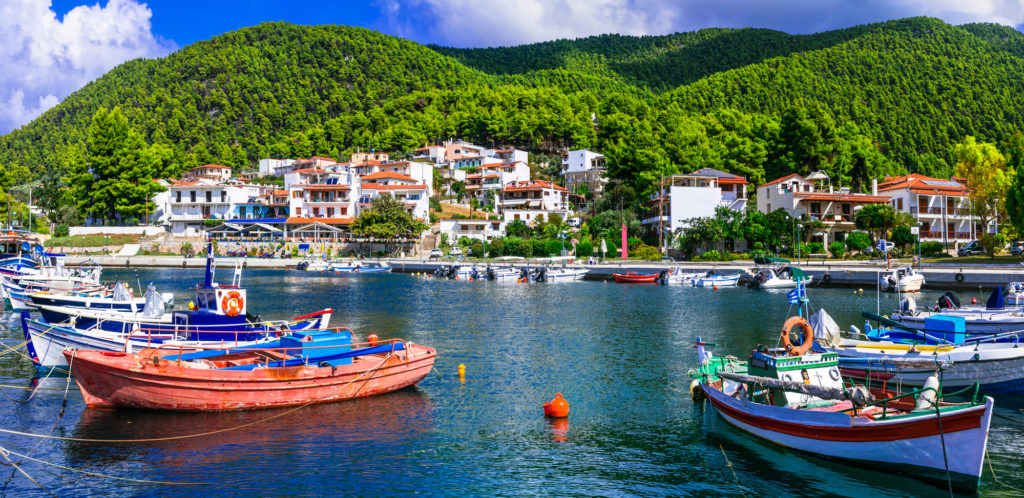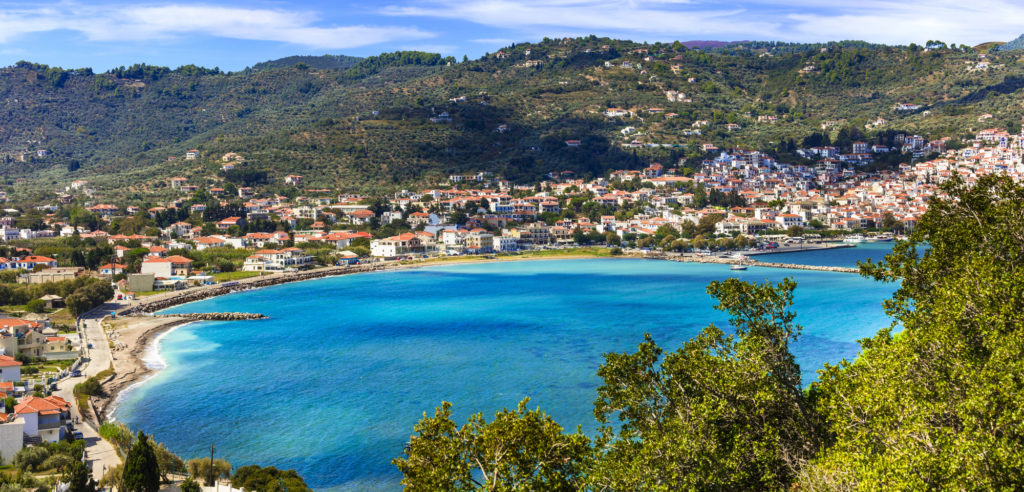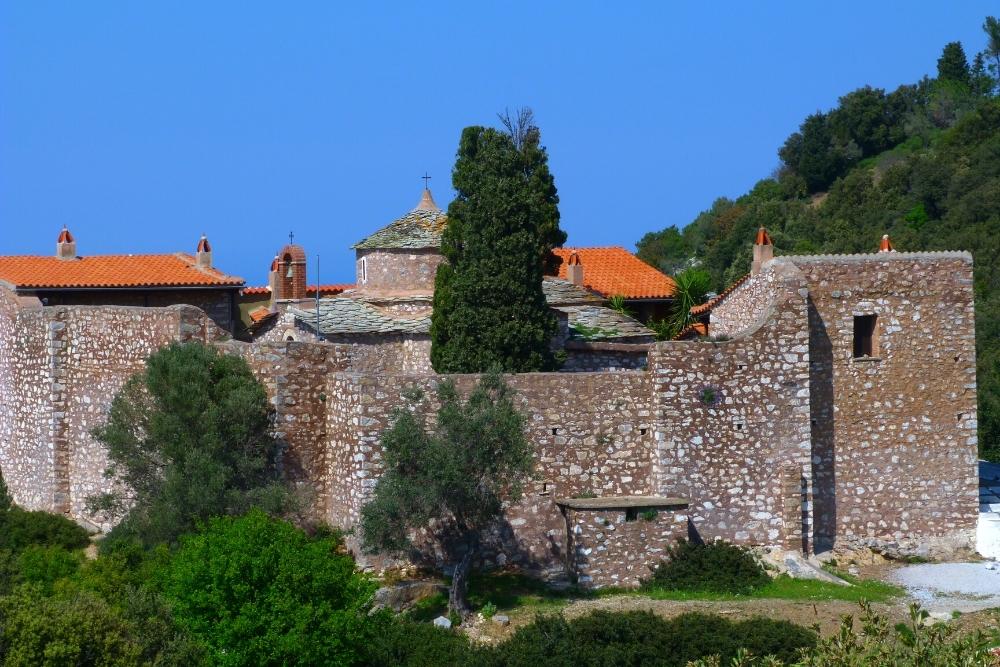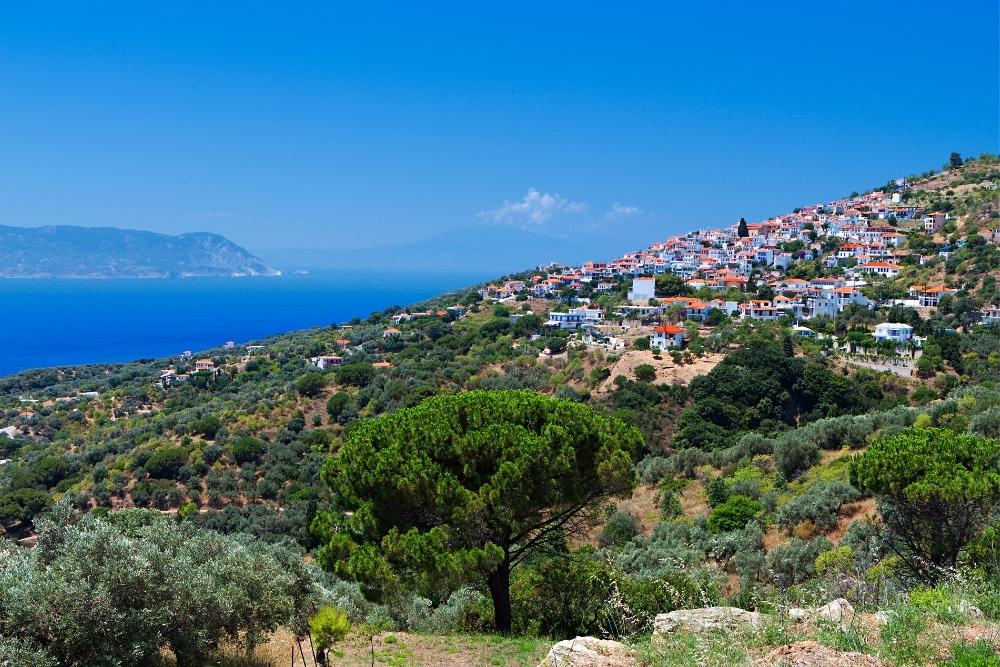Skopelos is an island that is blessed with pristine natural beauty and has had the good fortune to receive an unexpected marketing boost with the filming here of the musical Mamma Mia!. The famous film production has turned this island in the Northern Sporades archipelago into a tourist magnet.
But of course, this would not have been possible without Skopelos having its own special charm. Skopelos is a magical destination, adored both by its inhabitants and by those who choose to visit and spend their holidays here, a place where the ancient Greeks, Byzantines, Venetians, Ottomans, and pirates left their mark on various periods of history.
- History of Skopelos Island
- What to do and see on Skopelos Island
- Map with main tourist attractions in Skopelos Island (zoom for details)
- Skopelos Town
- Agios Ioannis Monastery
- Agia Varvara Monastery
- Glossa village
- Best beaches in Skopelos
- Best hotels in Skopelos
- Best restaurants in Skopelos
- How to get to Skopelos
- Pin it!
History of Skopelos Island
A rich history rooted in mythology tells of the first inhabitant of Skopelos: Staphylus, son of the god Dionysus and Princess Ariadne of Crete. The actual history of the island does not include many post-Mycenaean elements. However, it is known that between the 5th and 6th centuries BC, the island was known as Paparethos, as engraved on silver coins from that period when trade was conducted with other city-states in the Aegean. Paparethos exported olive oil but especially high-quality wine, known for its aphrodisiac effects.

The participation of the Paparethians in the ancient Olympic Games testifies to the island’s contribution to important events in ancient Greece. During the Games in 569 BC, the runner Hagnon, from Peparethos, won the famous Stadion race. The island’s then inhabitants put Hagnon’s portrait on coins in his honor. Also, the bay where he returned home victorious was named in his memory – Agnontas.
There were periods of Persian and Spartan, Roman, and Macedonian (in the Hellenistic period) rule. The name Skopelos is first mentioned in some texts from the time when the island was part of the Roman Empire – around the 2nd century BC, most likely because of the Romans stationed here (skopeloi, in Greek), but also because of the corals surrounding its coast.

Skopelos is not much mentioned in manuscripts in the Byzantine period, being considered a place of exile. The Venetians occupied it, then reincorporated into the Byzantine Empire, taken over by the Ottomans, returned to the Venetians, again conquered by the Ottomans, who plundered and depopulated it. It recovered somewhat towards the 18th-19th centuries, when a prosperous city developed on the island, with intense trade.
Skopelos experienced the beginning of its tourist development in the 1980s when the young population rediscovered the island’s beauty and thus stopped migrating abroad or to the big cities of mainland Greece. What’s more, many locals who had already left returned to develop tourist businesses in the summer.
What to do and see on Skopelos Island
Skopelos is also known as the blue-green island. And that’s not just because of the fabulous color of the waters surrounding it, but also because it’s one of the ‘greenest’ islands in the Aegean, covered in pine forests that contribute to the breathtaking scenery.
Map with main tourist attractions in Skopelos Island (zoom for details)
The two main towns of Skopelos are Skopelos (or Chora) and Glossa, plus a third port – Agnontas. There are more than 360 churches and monasteries on the island, some of them perfectly set in the natural landscape of the slopes of the Delphi or Palouki mountains. The beaches of Skopelos, although pebbly, add to the paradisiacal scenery and invite tourists to relax and rest.
Skopelos Town

The island’s capital is Skopelos (or Chora). White, terracotta-roofed houses ‘perched’ on hillsides amidst charming bougainvillea bushes along cobbled alleyways (cars are not allowed in the center of Chora). It is a kind of love at first sight with the view it offers to those who approach the island by ferry.

One such alley starts from Pigadaki, above the town, and leads to the 13th-century Venetian castle built by the Gyzi family. The castle walls are quite well preserved, and the view from here impresses everyone. As all the “brave” ones will be impressed by the tavern at Kastro (the name of any Greek castle), where you can listen to old rebetiko music, the precursor of bouzouki music.
On the way back from the castle, it’s impossible not to notice the significant number of churches that dot Skopelos Town – there are no less than 120 of them, the oldest dating back to the 11th century. Positive energy is brimming in this town. Other points of interest include the home of writer Pavlos Nirvanas, the Folklore Museum, the Vakratsa mansion, and the Asclepieion archaeological site in Ambeliki (to the right of the harbor).
Agios Ioannis Monastery

Those who have seen Mamma Mia! will immediately recognize this monastery where Sophie’s wedding scene was filmed. Agios Ioannis was built on a cliff in the face of winds and waves. There are 198 steps to climb up to the monastery on an isthmus 100 meters above the sea. A significant effort that is forgotten once you reach the top and look out over the landscape. A small beach has formed beneath the cliff on which the monastery sits, usually very crowded in summer.
Agia Varvara Monastery

6km north of Skopelos Town, near the Agios Ioannis Monastery, is the Agia Varvara Monastery, built in 1648. It is a fortified monastery, surrounded by thick walls, with a fabulous location offering exceptional sea views.
Very well preserved, the monastery of Agia Varvara is now abandoned by the monks but is worth visiting for the beauty of the landscape and the Byzantine icons and 15th-century frescoes inside.
Glossa village

The village of Glossa has a distinctive settlement in northwest of Skopelos, with houses arranged in amphitheater-style just above Loutraki harbor. Glossa is the second-largest settlement on Skopelos, which fascinated the Greek writer Alexandros Papadiamantisvas, who called it ‘the village above’ in his novel I Nostalgos.
Glossa (whose name would translate as tongue) is located in an area full of natural springs. The villagers grow olive trees, almond trees, plum trees, and tend vineyards. Evidence of human existence dating back to the Palaeolithic has been found here. The Dance Festival is held every August, followed by Stafylofest – the wine festival – in the last week of September.


Also, in Glosa you can visit the Cultural Heritage Museum and the Perseus Athineos Library, which have been open to the public since 2008. These cultural institutions aim to preserve and promote the cultural history of Skopelos through the naval history of the place, manuscripts, and personal objects belonging to various locals. The museum is housed in a renovated stone house, built in 1926, which has a balcony overlooking the whole village and the Aegean Sea.
Best beaches in Skopelos
Known for their crystal clear waters and the ‘green’ landscape surrounding them, the beaches of Skopelos (there are at least 18 of them!) have this relatively rare feature – rich vegetation that stretches almost to the seashore. Among the most popular beaches in Skopelos are Panormos, Hovolo, and Stafylos.
Panormos Beach

Panormos is a beach in the same name resort, tucked away in a cove about 12km from Skopelos Town. Despite being a small beach, Panormos has many facilities, including tavernas, a mini-market, ATM, and a water sports center. The beach is pebbly, and the clear water color is a deep blue. In the evening, from Panormos, you can watch the sunset among the pine trees covering the hill that borders the bay.
Hovolo Beach

Stretching along the island’s northwest coast, Hovolo is a pebbly beach set in front of impressive limestone cliffs covered with bushes of vegetation. It’s not an easy beach to get to, but the effort will be rewarded as the beach’s natural beauty is outstanding. Hovolo beach is not landscaped; however, it is quite crowded in summer.
Stafylos Beach

Located 4.5 km from Skopelos Town, Stafylos Beach is a mixed sand and pebble beach with umbrellas, sun loungers, and a bar in a beautiful setting. It’s a very popular beach, which is why in the peak months it’s always busy, with tourists coming here to enjoy the good swimming water and the surrounding hills and the natural spring nearby. Snorkeling can be practiced in good conditions on Stafylos beach.
Other beaches in Skopelos

If you are not satisfied with the ones above, you may also search for: Elios beach, Milia beach, Kastani beach, Loutraki beach, Agnondas beach, Glyfoneri beach, Adrina beach, Limnonari beach.
Best hotels in Skopelos
Adrina Beach Hotel ****
Booking rating: 9.4

Adrina is a beautiful hotel located in Panormos Bay, a few steps from Adrina Beach. Here you get a magical combination of tourist facilities and a magical location. The hotel has a swimming pool, spa, bar, garden with barbecue, parking, etc. You can stay in small cottages that can accommodate 2-4 people, excellently equipped.
Skopelos Village Hotel *****
Booking Note: 9

The complex has an ideal location, 600 m from the center of Skopelos and the harbor. In addition to exceptional sea views, Skopelos Village offers 35 rooms and apartments decorated to inspire a relaxing holiday. Two swimming pools, free internet, and free parking.
Natura Luxury Boutique Hotel Skopelos *****
Booking rating: 9.4

Located in Loutraki, Natura Luxury Boutique Hotel features modernly designed rooms, apartments, and studios that can accommodate 2-5 people, well-equipped, and private balconies.
Some rooms even have a jacuzzi. There is a bar, restaurant, breakfast place, spa, and swimming pool outside the room.
Best restaurants in Skopelos

Faros Skopelos
The restaurant is located in the Aegean Wave Hotel from April to October. The menu includes many traditional Skopelos dishes, all prepared with local ingredients and tested to perfection by the hotel owner.
Manolis Tavern
A tavern that has been operating for half a century and continues to serve its guests generation after generation. Rich assortments of Greek dishes, fresh fish, and barbecue in a garden overlooking the sea.
Finikas
A good dining option in Skopelos Town, a restaurant recommended by customers who have passed through its doors and sampled its meatballs, salads, stuffed pork and fruit cake. Finikas is known as a place where the service is impeccable and the prices decent.
How to get to Skopelos

There is no airport on the island of Skopelos, the nearest being in the archipelago’s neighbor, Skiathos. Alexandros Papadiamantis International Airport in Skiathos serves flights from Athens all year round (flight time from the Greek capital – about 30 minutes) and from various European locations in summer. From Skiathos, you will need to take a ferry to Skopelos.
Of course, you can also get to Skopelos directly by ferry from the port of Volos on the mainland. In summer, there are also some ferry trips from Kymi, a port on the island of Evia, and from Mantoudi, on the same island.
Pin it!


You may also like: Symi Island, the colorful world of the Dodecanese archipelago




